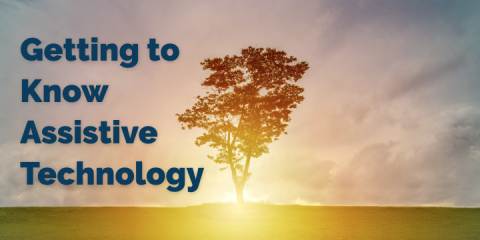Getting to Know Assistive Technology

Expert Contributor: Kit Piltingsrud, Program Manager and Assistive Technology Professional, Living Well Disability Services
Assistive technology devices can either be created at home, purchased and used off the shelf, modified, and/or customized to meet individual goals and needs. From low-tech options such as toy or game modification to high-tech devices that include voice recognition or elopement monitors, assistive technology is empowering those with disabilities to live, work, and play in the most independent way possible.
What’s the difference between no-, low-, mid-, and high-tech?
No-Tech: No-Tech solutions make use of procedures, services, and existing conditions in the environment and don’t involve the use of special devices or equipment. Examples include pencil grips, colored paper, extra time for testing, and the use of a scribe, reader, or interpreter.
Low-Tech: Low-Tech devices are simple devices that have few mechanical parts and don’t require a power source. They include adapted spoon handles, adapted pens, canes, non-tipping drink cups, magnifying glasses, eyeglasses, and Velcro fasteners. At most, only limited training would be necessary to use these devices.
Mid-Tech: Mid-Tech devices are relatively complicated mechanical devices that may require a power source but don’t contain sophisticated electronic systems. These devices include manual wheelchairs, talking calculators, adapted computer keyboards and mice. The operation of mid-tech devices requires some training and technical knowledge.
High-Tech: High-Tech devices are often computer-based systems that incorporate sophisticated electronics. These devices are complicated to use and require extensive training, technical knowledge, and access to technical support. Due to their sophisticated electronics, high-tech devices are often much more expensive than other technologies. Examples include speech recognition software, eye gaze-controlled computers, closed caption televisions (CCTV), power wheelchairs, and environmental control units.
What types of Assistive Technology are out there?
There are several common categories in which assistive technology devices may be grouped, including (but not limited to):
Aids for Daily Living – Aids for use with daily tasks such as dressing, eating, cooking, bathing, etc
Environmental Controls – Electronic and non-electronic aids that help control items like lights, appliances, TV, air/heat
Mobility – Aids to assist individuals with limited to no mobility such as wheelchairs, automatic page turners, chair lifts, or hand controls
Seating and Positioning – Aids to assist with comfort and positioning including seat cushions, wheelchairs, adaptable work stations, vertical standers
Communication Aids – Verbal and non-verbal communication aids such as pointers, picture boards, type-to-talk or text-to-speech devices
Computer Access – Computer operation aids such as word prediction, keyguard, programmable keyboards, modified mice, screen readers, or voice recognition software
Blindness and Visual Impairment – Aids assisting those with vision loss or low-vision such as screen readers, video magnifiers, and braille watches
Deafness and Hearing Impairment – Assistive devices for all levels of hearing loss such as amplifiers, listening devices, or alert systems
Cognition and Learning Disabilities – Materials, devices, or programs that make an education curriculum accessible to students with disabilities such as raised line paper, talking calculators, scan and read programs, text-to-audio systems, and symbol based adaptive keyboards
Recreation and Leisure – Assistive technology providing opportunities for individuals to benefit from play, sports, and the arts, such as adaptive sporting equipment and games, or arm supports for drawing/painting
Vehicle Modification – Aids to help in vehicle operation such as modified hand controls, wheelchair lifts, power seats, and adjusted pedals
Finding the Right Device
When assessing possible AT solutions, providers will perform an initial evaluation and begin exploring options beginning with no-tech, low-tech, and mid-tech before recommending high-tech solutions. This will help achieve an ideal person/technology match and helps ensure the most cost-effective solution is being utilized.
Below are a few Minnesota resources that showcase and/or loan out assistive technology tools and devices to help individuals achieve a more independent lifestyle.
Courage Kenny Rehabilitation Institute on Pinterest
Courage Kenny Rehabilitation Institute has put together Pinterest Boards showcasing many assistive technology options. From medication reminders to home assistants, and even DIY assistive technology devices including homemade styluses, playing card holders, or grips to make holding a pen or pencil easier, the Boards showcase numerous items and devices to help increase self-sufficiency for those living with disabilities.
View Courage Kenny Assistive Technology on Pinterest
PACER Simon Technology Center Lending Library
The Simon Technology Center Lending Library houses more than 1700 assistive technology items and devices that are available for individuals and families to borrow and try out before making a purchase. This allows individuals to find the right fit for them without having to purchase each piece of equipment they may be interested in.
Learn more about the Lending Library and membership options
Minnesota STAR Program
The Minnesota STAR program is federally funded by the Department of Health and Human Services. The STAR program offers device demonstrations, exchanges, loans, re-utilization, and more.



